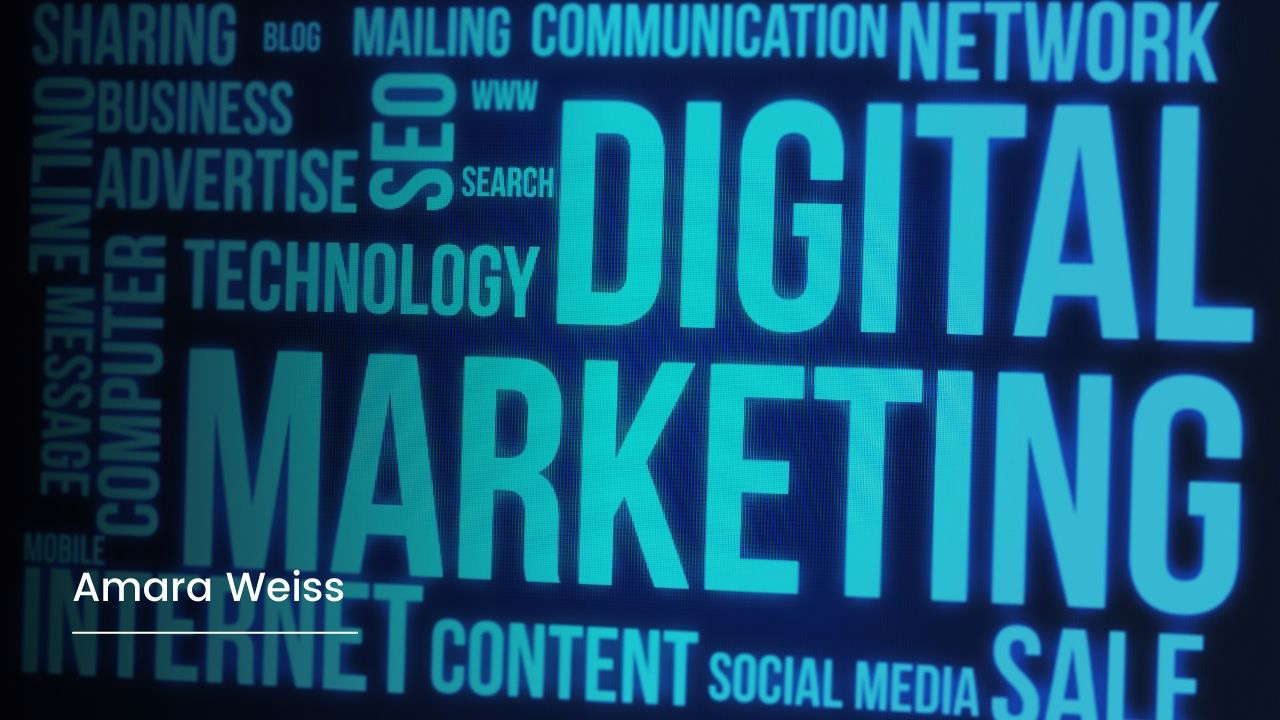
As the digital marketing landscape evolves, it's more important than ever to understand all the critical skills required for success. This guide covers everything from SEO and social media to email and content marketing, providing a clear and concise overview of each topic. It also features up-to-date information on the latest changes in the digital marketing landscape, keeping your skills sharp and staying ahead of the curve. So whether you're just getting started in digital marketing or looking to take your career to the next level, this guide will give you the foundation to succeed.
The most comprehensive guide to digital marketing skills is the one that covers all the key areas of marketing, including SEO, social media, email marketing, and content marketing. This guide should also provide a clear and concise overview of each of these areas to quickly learn the basics and then move on to more advanced concepts. In addition, the guide should be updated regularly to keep pace with the latest changes in the digital marketing landscape. By following this guide, you will be able to develop a strong understanding of all the essential digital marketing skills and build a successful career in this rapidly growing field.
What digital marketing skills are in demand today, and why
In the rapidly evolving world of digital marketing, it can be challenging to keep up with the latest trends. However, there are a few skills that are always in demand. First and foremost, effective communicators are highly valued in any marketing role. Being able to articulate ideas and objectives is essential for success. Additionally, marketers need to be well-versed in analytics and data interpretation. With so much information available, it's critical to identify what is relevant and actionable. Finally, a strong understanding of SEO is crucial for any digital marketer. As search engines continue to evolve, being able to optimize content for maximum visibility is more critical than ever. By developing these core skills, you'll be well-positioned for success.
The different types of digital marketing skills you can learn.
As the world becomes increasingly digital, businesses are scrambling to keep up. They can do this by marketing their products and services online. However, effective digital marketing requires a specific skill set. Fortunately, you can learn many different types of digital marketing skills. For example, search engine optimization (SEO) is a technique that can be used to improve a website's visibility on search engine results pages. Social media marketing (SMM) involves creating and sharing content on social media platforms to promote a brand or product. And email marketing involves sending promotional messages to customers via email. These are just a few of the many digital marketing skills you can learn to stay ahead of the curve.
How to develop your digital marketing skills
In today's digital age, it's more important than ever to have strong digital marketing skills. From social media to email marketing, businesses of all sizes use the internet to reach new customers and promote their products or services. However, it can be challenging to know where to start with so many options available. If you're looking to develop your digital marketing skills, here are four tips to get you started:
1. Do your research. There are a lot of resources available online, so take some time to educate yourself about the different aspects of digital marketing.
2. Find a mentor. There's nothing like learning from someone who has experience in the industry. If you know someone who works in digital marketing, reach out and ask for advice.
3. Stay up-to-date. Technology is constantly changing, so it's essential to stay current on the latest trends and tools. This will help you be more efficient and effective in your work.
4. Be patient. Learning new skills takes time, so don't get discouraged if you don't see results immediately. Rome wasn't built in a day, and neither is a successful digital marketing career.
By following these tips, you'll be well on your way to becoming a digital marketing expert!
The best ways to improve your digital marketing skills
With the ever-changing digital marketing landscape, it can be challenging to keep up with the latest trends and best practices. However, there are a few key ways to improve your digital marketing skills and stay ahead of the curve:
Make sure to stay up-to-date on the latest industry news. This can be done by following relevant blogs and online publications.
Consider taking an online course or attending a conference or workshop. There are many great resources available that can help you learn more about digital marketing.
Don't forget to experiment.
Try out new tactics and see what works best for your business. By continuously learning and experimenting, you'll be sure to improve your digital marketing skills and stay ahead of the competition.
What to do if you don't have the required digital marketing skills
There's no doubt that digital marketing is one of the most in-demand skill sets today. With businesses of all sizes looking to get a leg up in the digital world, those with the know-how are in high demand. However, what if you don't have the required digital marketing skills?
If you're looking to break into the digital marketing field but don't have the skillset yet, there are a few things you can do. First, consider taking some online courses or attending a digital marketing conference or workshop. These can be great ways to learn the basics and feel what's involved in digital marketing. Additionally, many companies are now offering internships or entry-level positions specifically for digital marketing.
Digital Marketing Skills Checklist: What You Need To Know
As the digital world continues to evolve, so does the field of digital marketing. To stay ahead of the curve, it's important to update your skill set and knowledge base regularly. But with so many different areas to focus on, where should you start? To help you out, we've put together a digital marketing skills checklist. By becoming proficient in each of the following areas, you'll be well on your way to becoming a top-notch digital marketer:
SEO
Search engine optimization (SEO) is one of the most critical aspects of digital marketing. It helps your content be found by potential customers when they search for relevant keywords or phrases. To optimize your content for SEO, you'll need to do keyword research to find the right keywords to target and then incorporate those keywords into your content naturally and effectively. Additionally, you'll need to make sure your website is correctly optimized for SEO so that search engines can easily index and rank your content.
Social Media
Social media is another essential piece of the digital marketing puzzle, as it allows you to connect with potential and current customers on a more personal level. You can build relationships, interact with customers, and promote your brand through social media. When using social media for marketing purposes, it's important to create interesting and engaging content and post regularly so that your followers stay up-to-date on what's happening with your business.
Email Marketing
Email marketing is a great way to keep in touch with your customers and promote your brand. To be successful with email marketing, you'll need to build a list of subscribers, create quality content that will interest them, and send out regular newsletters or promotions. Additionally, you'll need to make sure your emails are properly formatted and optimized for delivery so that they don't end up in the spam folder.
Content Marketing
Content marketing is all about creating valuable, relevant, and engaging content that will interest your target audience. This can include blog posts, articles, infographics, videos, or any other type of content that provides value to your readers. To be successful with content marketing, you'll need to create high-quality content regularly, promote your content through social media and other channels, and track the performance of your content so that you can continually improve it.
Digital marketing is an ever-changing field, so it's important to keep your skills up-to-date if you want to succeed. By following this guide, you'll be well on your way to becoming a digital marketing expert.
PPC advertising
Pay-per-click (PPC) advertising is a form of digital marketing in which you pay to have your ads displayed on search engines or other websites. When someone clicks on your ad, you pay the specified amount, and then your ad is displayed to that person. PPC advertising can be an effective way to drive traffic to your website or promote your products and services, but it's important to understand how it works to create an effective campaign.
Display advertising
Display advertising is a form of online advertising that involves displaying banner ads or other advertisements on websites. Display ads can be static or animated, and they can be text-based or image-based. Display advertising is a great way to reach a large audience, but it's important to create relevant and interesting ads so that people will click on them.
Native advertising
Native advertising is a form of online advertising that involves displaying ads that are similar in format to the content they're being displayed next to. For example, if you're displaying a native ad on a website about travel, the ad might take the form of an article about a specific destination. Native advertising can be an effective way to reach your target audience. Still, it's important to ensure that the ads are relevant and not intrusive so that people don't get annoyed and stop reading your content.
Digital marketing is an ever-changing field, so it's important to keep your skills up-to-date if you want to succeed. By following this guide, you'll be well on your way to becoming a digital marketing expert.
Marketing automation
Marketing automation is a form of digital marketing that uses software to automate marketing tasks. This can include sending out automated email campaigns to managing your social media accounts. Marketing automation can save you a lot of time, but it's important to understand how it works to use it effectively.
Inbound marketing
Inbound marketing is a form of digital marketing that focuses on attracting customers to your website or business through various channels, such as search engine optimization (SEO), social media, and content marketing. Inbound marketing is a great way to reach your target audience. Still, it's important to ensure that your website or business is optimized for conversion to turn those visitors into customers.
Outbound marketing
Outbound marketing is a form of digital marketing that involves reaching out to potential customers through various channels, such as email, cold calling, and online advertising. Outbound marketing can be an effective way to reach your target audience, but it's important to ensure that you're not being too aggressive or spammy so that people don't get turned off by your messages.
Digital marketing is an ever-changing field, so it's important to keep your skills up-to-date if you want to succeed. By following this guide, you'll be well on your way to becoming a digital marketing expert.
Web analytics
Web analytics is analyzing data from your website to better understand how people are using it. This can include anything from understanding which pages are most popular to seeing what keywords people use to find your site. Web analytics is a great way to improve your website or business, but it's important to understand how it works to use it effectively.
Join over 100,000 students who are learning to market like experts
If you're interested in marketing, there's no better place to start than our digital marketing course. This course is designed for students who want to learn the basics of digital marketing, and it covers everything from market research to advertising and promotions. Plus, it's taught by some of the top marketing experts in the world. With over 100,000 students already enrolled, you can be sure you're getting the best possible education when you take this course. So what are you waiting for? Enroll today and start learning how to market like an expert!
So, what are the digital marketing skills in demand today? And how can you develop them? The good news is that there are plenty of ways to improve your skills. You can join a course or workshop, read books and articles, watch videos, listen to podcasts, or practice on your website. The best way to learn is by doing, so get started today! What's holding you back? If you don't have the required skills yet, don't worry – we can help you get up to speed quickly with our digital marketing courses. Join us and become a digitally savvy marketer!
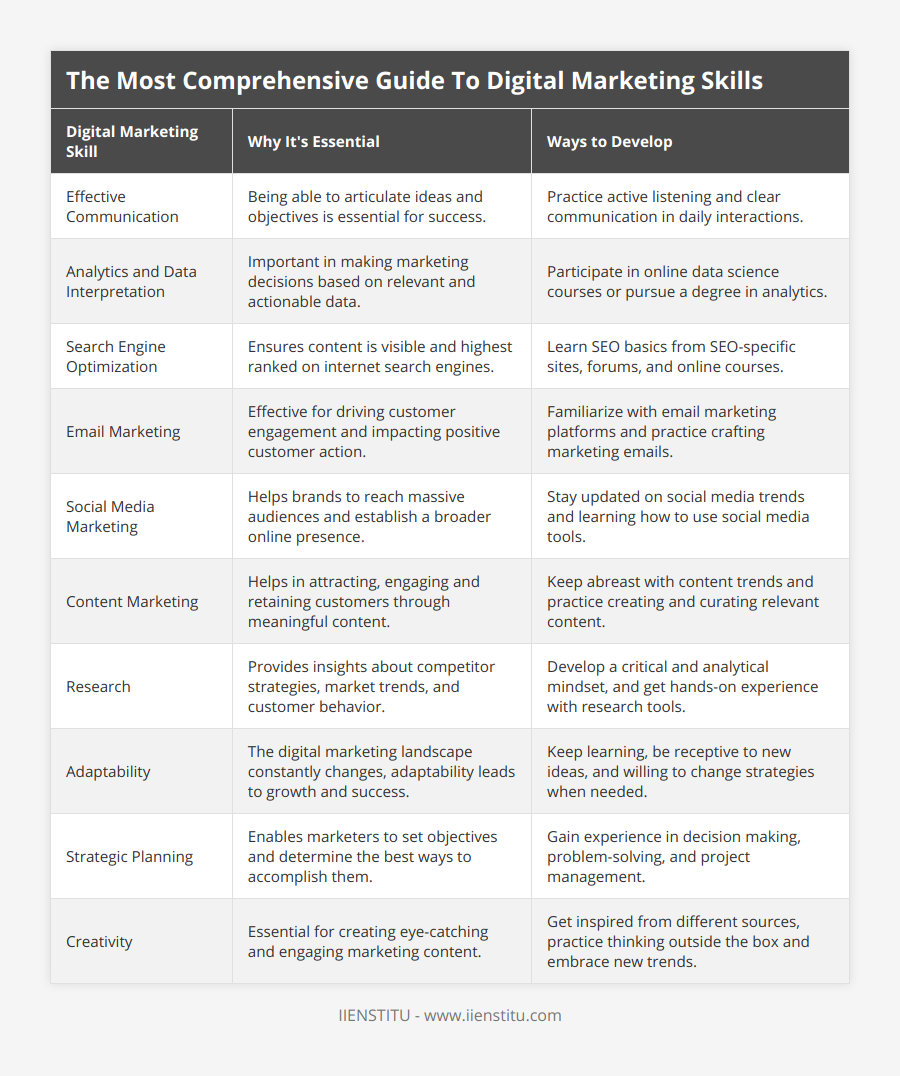
Frequently Asked Questions
What are the most important skills for digital marketing?
Analytical Skills
One crucial skill for digital marketing professionals is the ability to analyze data and make informed decisions. Digital marketers rely heavily on data-driven insights to identify patterns and trends, and hone in on effective strategies. This skill is essential for optimizing campaigns, increasing ROI, and planning future initiatives.
SEO and SEM Knowledge
Search engine optimization (SEO) and search engine marketing (SEM) are vital skills for digital marketers, as they ensure that online content is visible and easily accessible to target audiences. A firm understanding of keyword research, on-page optimization, content marketing, and link-building techniques are necessary to optimize websites for organic search results and paid advertisements.
Social Media Expertise
Social media platforms play a significant role in digital marketing, and effective communication on these platforms is integral to an organization's success. A digital marketer must understand how to craft compelling content tailored to each platform, be it Facebook, Twitter, Instagram, or LinkedIn. They should also be skilled in managing company profiles, engaging with followers, and cultivating brand awareness.
Content Creation
The ability to create compelling, shareable content is indispensable in the digital marketing sphere. This includes writing persuasive copy for landing pages, blog posts, social media captions, and email campaigns. Skill in visual content creation, such as graphic design and video production, is also highly valuable, as it helps to communicate the brand narrative and drive engagement through various channels.
Email Marketing
Email marketing remains an essential component of digital marketing efforts, allowing businesses to create personalized experiences for customers and nurture long-term relationships. Proficiency in email marketing tools, list segmentation, email automation, and A/B testing techniques is necessary to deliver targeted and relevant content that yields high open and conversion rates.
Technical Proficiency
Digital marketing professionals require an understanding of various digital tools, platforms, and technologies to achieve their objectives. This includes knowing how to use marketing automation tools, social media management platforms, analytics software, and content management systems. Knowledge of HTML, CSS, and JavaScript may be advantageous for troubleshooting and customizing different digital assets.
Adaptability and Continuous Learning
Lastly, the digital marketing landscape is constantly evolving, with changes in algorithms, policies, and consumer preferences requiring a consistent, adaptive approach to stay ahead in the game. Thus, successful digital marketers must be agile, embracing new tools and strategies and staying abreast of industry developments to maintain a competitive edge.

What are the 3 most important things in digital marketing?
**Key Elements of Digital Marketing**
The realm of digital marketing incorporates diverse strategies that enable businesses to reach their target audiences in the vast and ever-evolving online landscape. Notably, three essential aspects of digital marketing stand out for their proven effectiveness in driving engagement and enhancing business performance.
**Content Strategy**
First and foremost, creating and distributing quality, relevant, and engaging content is critical for success in digital marketing. Content strategy refers to the development and implementation of a cohesive plan that focuses on producing valuable and informative resources for a brand's target audience. Businesses that consistently deliver top-notch content across various platforms, such as blog posts, social media accounts, and websites, can improve their online visibility, build credibility, and foster customer loyalty, all of which contribute to increased conversion rates and long-term growth.
**Search Engine Optimization**
Secondly, search engine optimization (SEO) is an integral component of an effective digital marketing strategy. Essentially, SEO encompasses a set of best practices and techniques aimed at improving a website's visibility on search engine results pages (SERPs) and thereby driving higher volumes of organic traffic. By optimizing web content with targeted keywords, incorporating user-friendly navigation, and ensuring the compatibility of web pages with mobile devices, businesses can improve user experiences, attract more visitors, and potentially enhance ROI.
**Social Media Marketing**
Lastly, the rise of social media has undoubtedly revolutionized the digital marketing landscape, creating numerous opportunities for businesses to engage with consumers and amplify their online presence. Social media marketing involves leveraging platforms such as Facebook, Twitter, Instagram, and LinkedIn to share content, interact with followers, and deliver targeted advertising campaigns. When executed effectively, social media marketing can foster brand awareness, bolster customer relationships, and ultimately drive sales.

What are the 5 A's of digital marketing?
Introduction to the 5 A's of Digital Marketing
Understanding the fundamental principles of digital marketing is key to the success of any online business or content creator. The 5 A's of digital marketing are essential techniques that can help organizations maximize their digital presence and connect with their target audience.
Attention
The first step in any digital marketing strategy is to capture the attention of your target audience. This can be achieved through eye-catching visuals, engaging headlines, and content tailored to your target demographic. Additionally, utilizing search engine optimization (SEO) can help boost the visibility of your content in search engine results.
Acquisition
Once you have captured the attention of potential customers, it is crucial to convert these individuals into leads or subscribers. This can be achieved through offering valuable content, such as informative blog posts, e-books, or exclusive deals that encourage users to provide their email address or contact information. Effective calls-to-action (CTA's) can also play a role in driving potential customers towards conversion.
Activation
Activation refers to the process of encouraging newly acquired leads to take a desired action, such as making a purchase or subscribing to a service. To achieve this, it is essential to create a seamless and user-friendly experience on websites and landing pages. Personalization and targeting based on user behavior can also help drive conversion rates.
Appreciation
Building lasting relationships with customers goes beyond the point of purchase. Marketers should continuously engage with customers and showcase their appreciation through follow-up communication, personalized offers, and rewards programs. Such efforts can result in repeat purchases and increased brand loyalty.
Advocacy
The final step in the 5 A's framework involves turning satisfied customers into brand advocates. Encouraging customers to share their positive experiences with your brand can lead to word-of-mouth marketing and expand your online reach. Social media platforms and review sites are powerful tools for facilitating customer advocacy.
In summary, the 5 A's of digital marketing serve as a comprehensive framework for effective digital marketing strategies. By capturing attention, acquiring leads, activating customers, showing appreciation, and encouraging advocacy, businesses can effectively navigate the digital landscape and maximize their return on investment.
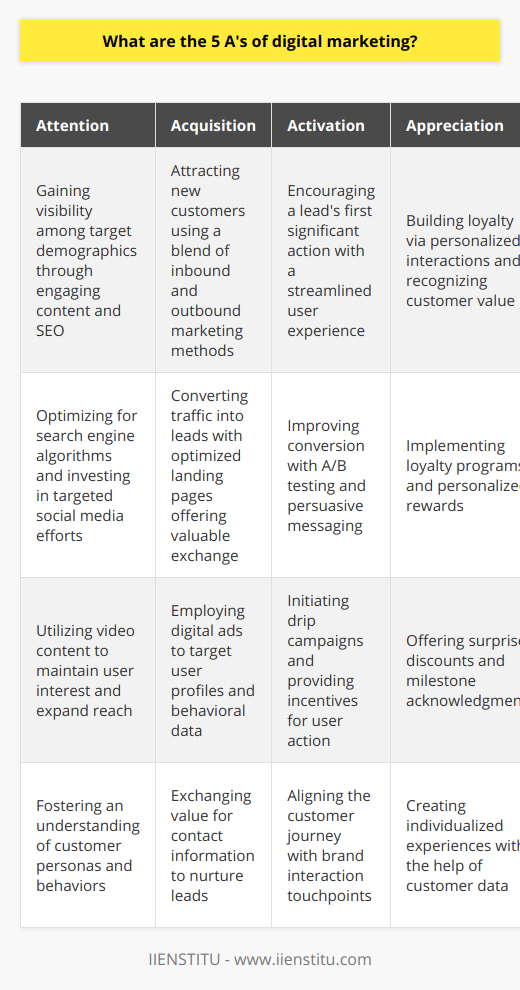
What are the 4 C's of digital marketing?
The Four C's of Digital Marketing
Understanding the Concept
The first C of digital marketing refers to the concept of integrated marketing communications, which emphasizes a customer-centric approach to digital marketing. Customers are not seen as mere passive consumers of advertisements, but rather active participants with their unique preferences, interests, and needs.
Creating Content
The second C, content, is essential because it is the foundation through which businesses can engage with customers and build relationships. High-quality, relevant content is necessary to capture the attention and loyalty of potential customers. Additionally, content should be tailored not only toward specific target audiences but also to different stages in the customer journey, from awareness to decision-making.
Curation of Content
The third C, curation, refers to the process of organizing, filtering, and presenting content in a way that maximizes its impact on consumers. With the overwhelming amount of information available online, it is vital for marketers to curate content that appeals strategically to their target audience. This can include choosing the right media channels, using compelling visuals, developing a coherent message, and engaging with consumers through comments and feedback.
Measuring Campaign Success
Finally, the fourth C, conversion, is a critical aspect of any digital marketing strategy. This involves tracking and measuring the success of marketing efforts to ensure that investment in content creation and curation is generating a return. Methods for evaluating conversion may include monitoring website traffic, analyzing bounce rates and click-through rates, assessing social media engagement, and measuring sales data. By understanding and optimizing these various metrics, marketers can refine their strategies and achieve better results in the digital landscape.
In conclusion, the four C's of digital marketing - concept, content, curation, and conversion - represent an essential framework for businesses looking to optimize their digital marketing strategies. Focusing on these elements helps organizations create and deliver tailored, engaging content to their target audience, facilitating long-term customer relationships and driving growth.
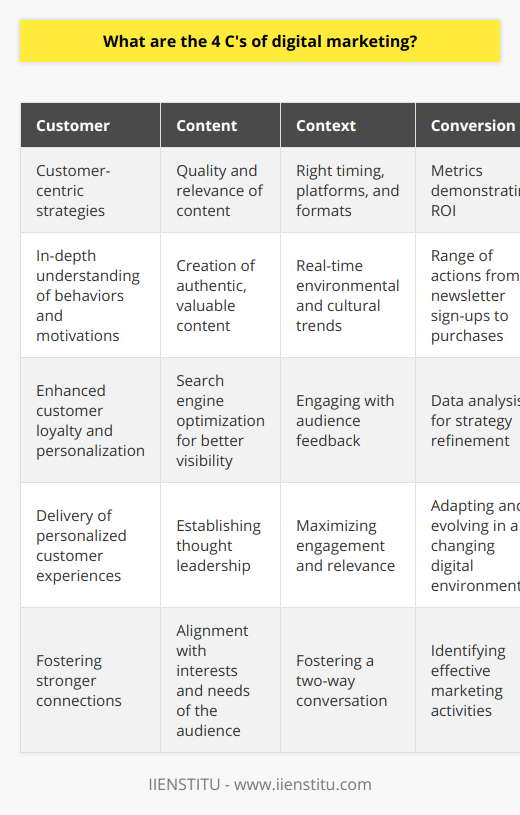
What are the key differences between traditional and digital marketing?
Key Differences Overview
Traditional marketing refers to various offline promotional methods, including print advertisements, billboards, and public relations campaigns. On the other hand, digital marketing encompasses online promotional strategies such as social media, search engine optimization, and content marketing. There are several key differences between these two approaches to marketing.
Reach and Engagement
Traditional marketing focuses on reaching a broad audience, with limited interactivity between the advertiser and the audience. Digital marketing, however, allows for targeted communication that can be adjusted based on customer engagement, resulting in a more personalized experience for the consumer.
Measurability and Data Analysis
Another crucial difference lies in measurability and data analysis. Traditional marketing measures effectiveness through sales, brand recall, or foot traffic, which can be challenging to accurately quantify. Conversely, digital marketing offers precise tracking through various tools, providing real-time analytics, conversion rates, and audience behavior, allowing businesses to optimize their strategies.
Cost and Investment
Traditional marketing, particularly print and broadcast media, can be expensive due to production and distribution costs. In contrast, digital marketing offers a more cost-effective approach, often requiring minimal investment for online platforms like social media and paid search, which can produce a higher return on investment.
Segmentation and Targeting
Traditional marketing has limited capabilities in segmentation and targeting, as it typically consists of mass distribution to a general audience. Digital marketing enables more precise targeting, allowing businesses to segment their audience based on demographics, interests, and browsing behavior, increasing the likelihood of reaching a receptive audience.
Interactivity and Feedback
Lastly, digital marketing offers interactivity, as it facilitates two-way communication between a brand and its audience, allowing for immediate feedback, prompt customer service, and fostering online communities. In comparison, traditional marketing methods provide limited opportunities for dialogue and interaction.
In conclusion, the key differences between traditional and digital marketing lie in their reach and engagement, data analysis capabilities, cost, audience targeting, and level of interactivity. As digital marketing continues to evolve with technological advancements, it is increasingly important for businesses to adapt and strategically incorporate these approaches to maintain relevance and achieve success in today's competitive market.

How do analytics play a role in the success of digital marketing campaigns?
Role of Analytics in Digital Marketing Campaigns
Understanding Consumer Behavior
Analytics play a crucial role in digital marketing campaigns by offering valuable insights into consumer behavior. Analyzing data on consumer interactions with advertisements, such as clicks, views, and conversions, allows marketers to understand their audience's preferences, interests, and motivations. This, in turn, enables the development of better-targeted campaigns, leading to higher engagement rates and ultimately, a more successful digital marketing endeavor.
Optimizing Campaign Performance
By utilizing analytics tools, marketers can easily track and measure the performance of their digital marketing campaigns. Key performance indicators (KPIs) such as click-through rates, conversion rates, and return on investment (ROI) can be analyzed to determine the effectiveness of marketing strategies employed. This information, when used strategically, can be leveraged to optimize campaign performance - making necessary adjustments to improve outcomes, eliminate wastage of resources, and maximize return on investment.
Personalizing Content and Messages
Digital marketing analytics also allow for the personalization of content and messages based on user behavior and profile data. Personalized content is known to garner higher engagement rates, as it appeals to the specific interests and needs of individual consumers. Tracking user preferences, browsing history, and behavior patterns enable marketers to create tailored content that resonates with their intended audience – resulting in more meaningful connections and increased conversions.
Driving Data-Driven Decisions
Analytics assists marketers in making data-driven decisions, both in the strategic planning stage and for ongoing campaign improvements. Such data-led decision-making fosters better outcomes, as marketing strategies are grounded in evidence-based insights, rather than relying on assumptions or guesswork. Additionally, implementing changes based on analytics results in a continuous cycle of improvement, as even further data is generated and assessed – ensuring that digital marketing campaigns stay informed and up-to-date.
In conclusion, analytics are an indispensable tool for digital marketing campaigns, as they allow for a deeper understanding of consumer behavior, facilitate performance optimization, enable tailored content creation, and encourage data-driven decision-making. By incorporating analytics into digital marketing strategies, marketers can better target their intended audiences, streamline their campaigns, and ultimately, elevate the overall success of their digital marketing efforts.

How has the evolution of digital marketing impacted the marketing strategies adopted by businesses?
The Shift to Digital Platforms
The evolution of digital marketing has significantly transformed the marketing strategies of businesses worldwide. Traditional marketing methods, such as print advertisements, billboards, and direct mail, have given way to online platforms such as social media, email marketing, and search engine optimization (SEO). This shift has occurred as both consumers and businesses increasingly rely on the internet for communication, entertainment, and commerce.
Audience Targeting and Personalization
One primary impact of digital marketing on marketing strategies is the ability to target specific audience segments with personalized messages. This approach allows businesses to identify niche target markets, enabling cost-effectiveness and delivering higher return on investment (ROI). Personalization has also become more sophisticated, incorporating data-driven insights from user behavior and preferences to better engage and connect with consumers.
Increased Importance of Data Analytics
The evolution of digital marketing has also placed greater emphasis on the role of data analytics in shaping marketing strategies. By collecting and analyzing data on consumer behavior, businesses can make more informed decisions on campaign design, budget allocation, and messaging. Data-driven marketing also facilitates testing and measurement of marketing activities, allowing marketers to optimize their strategies and improve overall performance over time.
Adoption of Mobile and Multi-Channel Strategies
The proliferation of smartphones and mobile devices has contributed to the rise of mobile and multi-channel marketing strategies. Businesses are now developing campaigns and content optimized for mobile platforms, recognizing that consumers often engage with multiple devices throughout the day. Simultaneously, marketers are adopting multi-channel strategies that seamlessly integrate online and offline marketing activities, providing a cohesive and consistent brand experience for consumers.
Emphasis on Customer Engagement
Lastly, digital marketing has shifted the focus from generating one-time transactions to fostering ongoing relationships with customers. Social media and content marketing, in particular, allow businesses to engage with their audience through valuable content and interactions, driving brand loyalty, and advocacy. This deeper level of customer engagement ultimately results in long-term benefits for businesses, as loyal customers are more likely to make repeat purchases and recommend the brand to others.

How can digital marketing be effectively integrated with traditional marketing methods?
Integrating Digital and Traditional Marketing Approaches
Effective integration of digital marketing with traditional marketing methods can bolster a company's overall strategy by reaching a wider audience and enhancing brand image. By understanding the benefits of both approaches, marketers can create a cohesive marketing plan that utilizes the strengths of each marketing method.
Underscoring the Complementary Nature
Firstly, it is important to recognize that digital and traditional marketing methods are not mutually exclusive. Rather, they complement each other in reaching the desired target audience. By embracing this concept, marketers can develop campaigns that work concurrently to achieve objectives.
Combining Outreach Channels
Reinforcing brand message through multiple channels is one way to integrate digital and traditional approaches effectively. Delivering consistent messaging through print ads, billboards, and radio commercials while reinforcing the same message through social media, influencer campaigns, and online ads can lead to a stronger customer recall.
Creating Cohesive Marketing Campaigns
Another essential aspect to consider is creating a cohesive marketing campaign that bridges the gap between traditional and digital methods. For instance, using QR codes on print ads can lead the audience to a company's website or social media profiles. Likewise, mentioning a URL or hashtag during radio or TV commercials can guide audiences to engage with digital content.
Leveraging Data Analysis
Incorporating data from both traditional and digital marketing campaigns is crucial for optimizing future efforts. By using digital analytics tools and offline audience insights, businesses can improve their targeting capacity and refine their strategies. This should result in a more personalized and impactful message that resonates with the target audience.
Enhancing the Customer Experience
Lastly, integrating digital marketing with traditional methods can enhance the overall customer experience. Businesses can enhance the customer journey by providing informative content via digital channels (e.g., blog posts, social media) and encouraging discussions with customer service through various traditional methods (e.g., telephone, email). This blended approach can foster a seamless connection between a brand and its customers.
In conclusion, achieving effective integration of digital and traditional marketing relies on recognizing the complementary nature of both approaches, utilizing multiple channels, creating cohesive marketing campaigns, leveraging data analysis, and enhancing the overall customer experience. By effectively combining these elements, businesses can maximize their reach and elevate the impact of their marketing efforts.
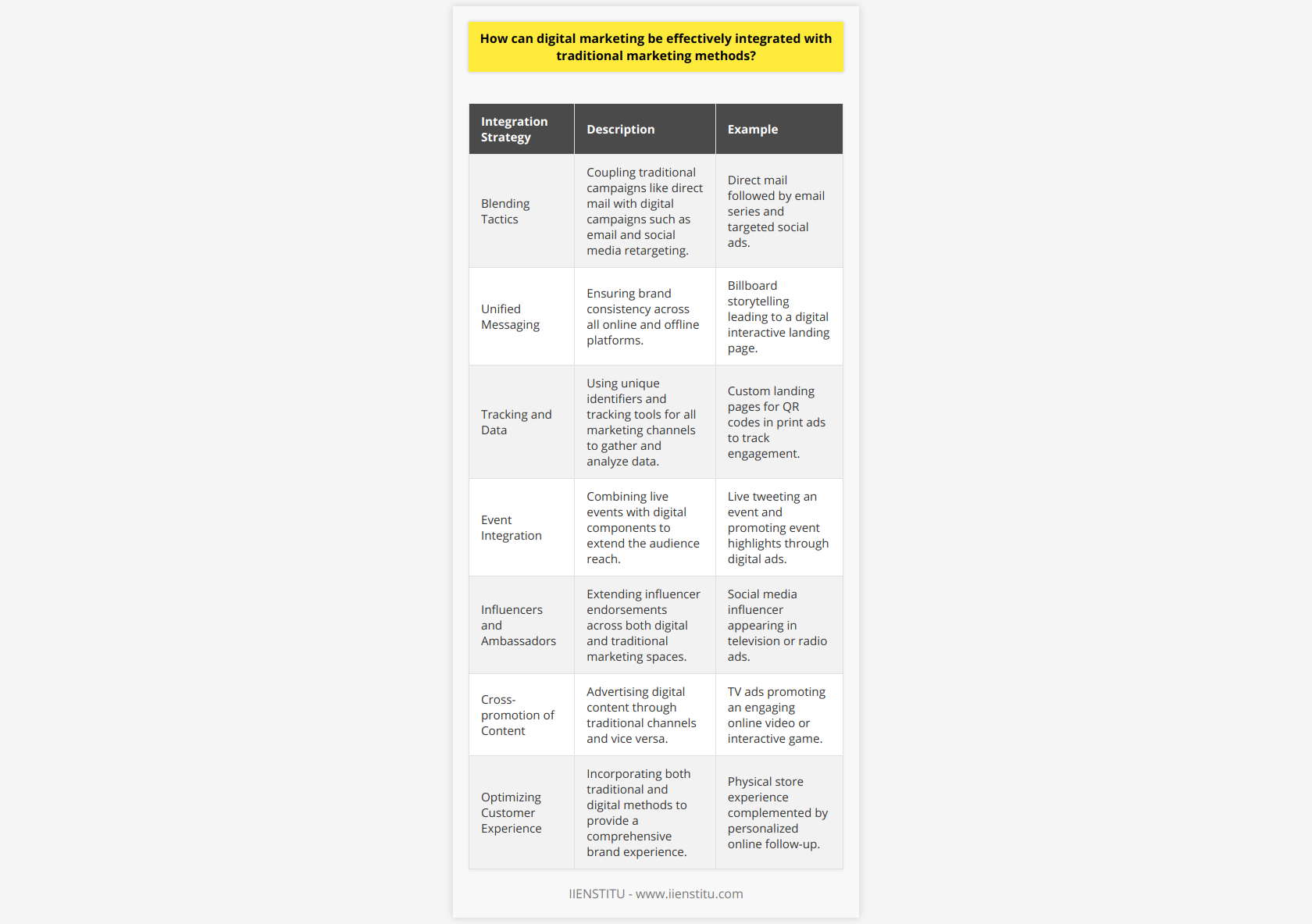
What role does content marketing play in enhancing the overall effectiveness of a digital marketing campaign?
Role of Content Marketing in Digital Campaigns
Relevance and Engagement
Content marketing plays a critical role in enhancing the overall effectiveness of a digital marketing campaign. It primarily involves the creation and distribution of high-quality, valuable, and relevant content to engage the target audience. By providing meaningful information, content marketing aims to establish a strong rapport with the consumers.
Brand Awareness and Credibility
Additionally, content marketing helps in increasing brand awareness and strengthening brand reputation. When the audience encounters engaging and informative content, it not only keeps them interested but also portrays the brand as an industry expert. Consequently, this fosters trust and credibility in the minds of consumers, thereby improving the brand's image.
SEO and Online Visibility
Content marketing also contributes to search engine optimization (SEO) and augments the online visibility of the brand. By incorporating relevant keywords into the content, marketers can effectively optimize their web pages for search engines. This, in turn, ensures higher rankings in search results and an increased likelihood of attracting potential customers.
Conversion and Retention
Another significant aspect of content marketing is its potential to drive conversions, engage with prospective buyers, and ultimately facilitate lead generation. By presenting helpful and pertinent content, the marketing campaign can gently persuade the audience to take action, converting them into customers. Moreover, consistently delivering quality content keeps the audience engaged, resulting in enhanced customer retention.
Social Media Engagement
Lastly, content marketing enables efficient social media engagement, as shareable content can have a powerful impact on digital marketing campaigns. By creating content that resonates with the audience on social media platforms, marketers can enjoy increased organic reach and engagement, which can positively impact the overall effectiveness of their campaign.
In conclusion, content marketing plays a vital role in enhancing the overall success of a digital marketing campaign by promoting audience engagement, bolstering brand credibility, optimizing SEO, driving conversion and retention, and boosting social media engagement. Implementing a robust content marketing strategy is integral to ensuring the sustainability and growth of any digital marketing campaign.
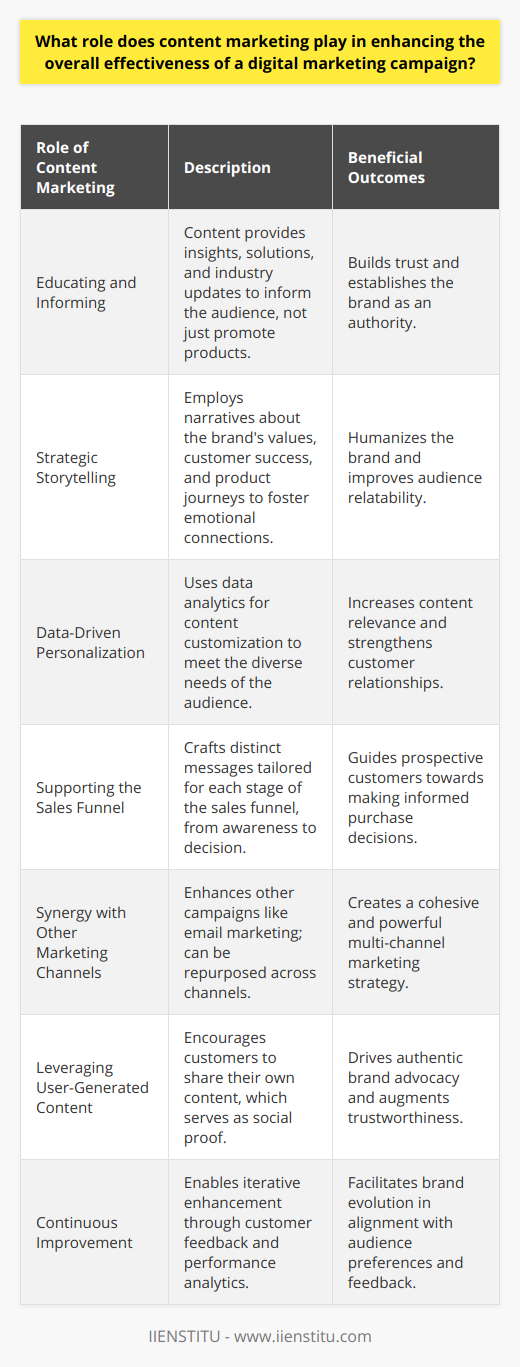
What are the 7 C's of digital marketing?
Seven Core Elements of Digital Marketing
Understanding Customer Needs
The first C in digital marketing is Customer-centricity. This principle emphasizes understanding customer needs, preferences, and behavior to create targeted and relevant content. By tailoring marketing strategies to individual customers or specific audience segments, businesses can achieve higher engagement and conversions.
Engaging Content
In the digital world, Content is king. High-quality, compelling, and engaging content is essential for attracting and retaining customers. Content can be delivered in various formats, including articles, videos, images, infographics, and podcasts, and should be consistent with the brand's voice, tone, and communication strategy.
Optimizing for Conversions
Conversion is a critical aspect of digital marketing, as it refers to the process of turning prospects into customers. This can be achieved through various strategies, such as call-to-action buttons, optimized landing pages, and tailored advertising campaigns. Marketers should continuously track and analyze conversion metrics to refine their strategies and improve overall performance.
Creating Connections
In digital marketing, Connection is about building relationships with customers through various online platforms. Social media, email marketing, and online communities provide opportunities for brands to engage with audiences on a deeper level, fostering brand loyalty and trust. Engaging with customers through personalized interactions can also lead to valuable insights for improving products or services.
Staying Consistent
Consistency in digital marketing involves maintaining a unified brand identity across multiple channels and devices, ensuring that the brand's message and aesthetic remain cohesive. Elements such as logo, color palette, typography, and tone should be consistent in all marketing materials, helping customers recognize and remember the brand easily.
Utilizing Channels
Effective digital marketing strategies encompass a variety of Channels that reach different customer segments. These channels include search engines, social media platforms, email marketing, and display advertising, among others. By selecting and optimizing the most relevant channels for a target audience, marketers can maximize visibility and reach.
Constant Improvement through Analysis
The last C of digital marketing is Continuous analysis, which emphasizes the importance of monitoring and measuring marketing activities' effectiveness. By tracking key performance indicators (KPIs), such as traffic, engagement, and conversion rates, businesses can identify areas for improvement and make data-driven decisions to optimize their marketing strategies. Continuous analysis also helps marketers stay up-to-date with industry trends and adapt to the ever-changing digital landscape.
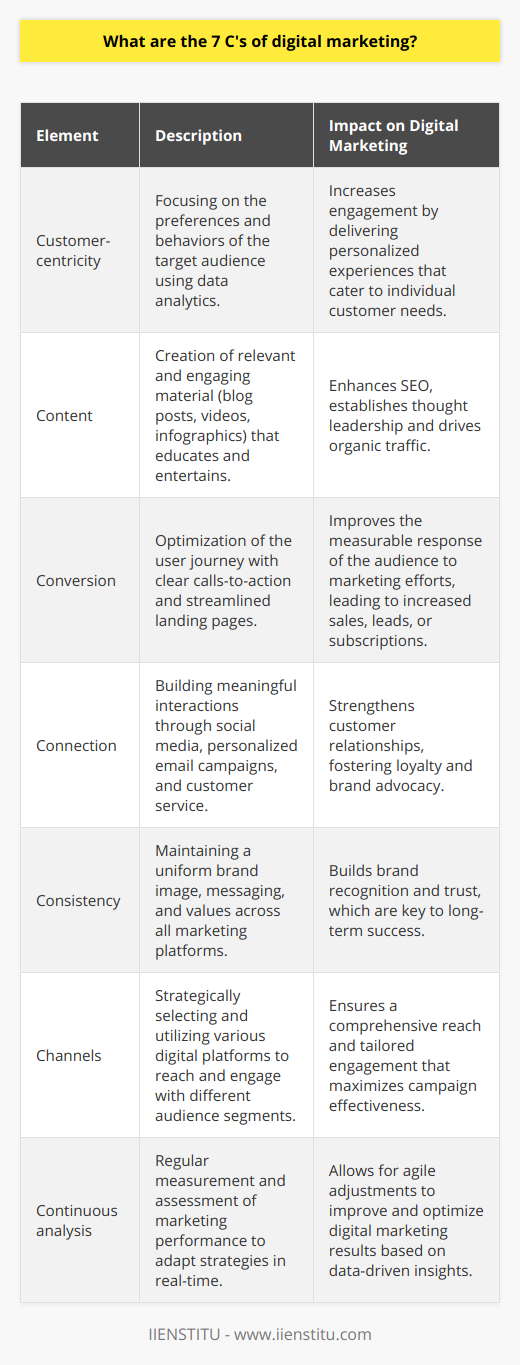
How does customer segmentation contribute to the success of a digital marketing campaign?
Understanding Customer Segmentation
Customer segmentation is the process of dividing a company's customer base into distinct groups based on demographic, behavioral, or psychographic factors. This method plays a crucial role in ensuring the success of a digital marketing campaign.
Targeted Messaging and Personalization
By understanding the different customer profiles, digital marketers can tailor their promotional messages to resonate with specific target audiences. The messages can be personalized to match the needs, preferences, and behaviors of individual customer segments. This targeted communication can lead to improved customer engagement and higher conversion rates.
Resource Optimization
Customer segmentation contributes to the efficient use of marketing resources. By identifying and targeting the most valuable customer segments, businesses can allocate their marketing budget and efforts more effectively. This focus on high-potential customers can result in cost savings and improved return on investment for the digital marketing campaign.
Improved Customer Retention
Digital marketers can continuously analyze the behavior, preferences, and interaction patterns of different customer segments. This information allows them to identify opportunities to develop better products or services and create more targeted marketing campaigns. Consequently, businesses could experience an increase in customer retention and loyalty, which can contribute to long-term success and profitability.
Data-Driven Decision Making
Customer segmentation enables digital marketers to make data-driven decisions regarding their targeted marketing campaigns. By leveraging customer data and analytics, businesses can identify which segments are particularly responsive to specific marketing tactics or channels. This insight can inform campaign strategies and decisions, increasing the likelihood of a successful digital marketing campaign.
In conclusion, customer segmentation is an essential aspect of digital marketing as it allows marketers to develop more targeted and personalized campaigns. This approach contributes to success by increasing customer engagement, optimizing marketing resources, boosting customer retention, and supporting data-driven decision-making processes.
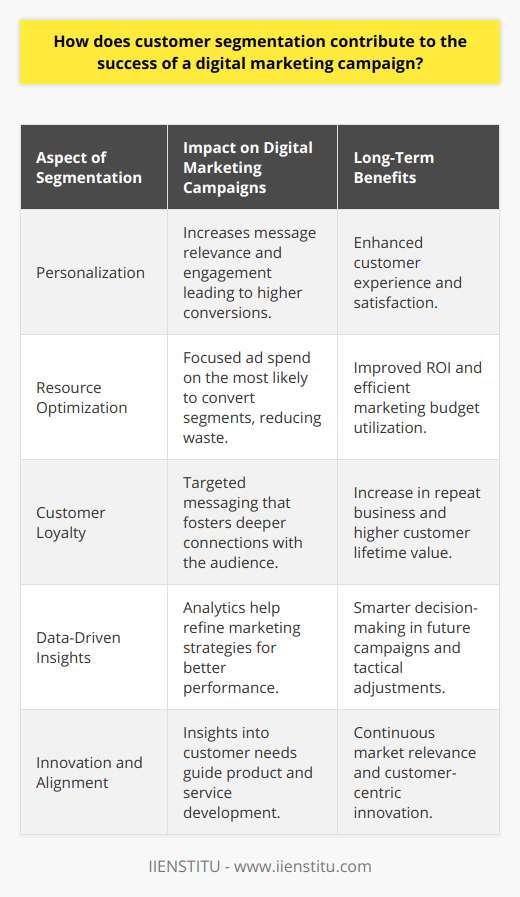
What are the key challenges faced by digital marketers when implementing data-driven marketing strategies?
Challenges in Data-Driven Marketing Implementation
Data Accuracy and Quality
One of the foremost challenges for digital marketers in implementing data-driven marketing strategies is ensuring the accuracy and quality of the data collected. Marketers need to gather data from a variety of sources, including social media, search engines, and websites. However, the data may contain inaccuracies, duplication, or outdated information, leading to skewed results and hindering the effectiveness of their marketing strategies.
Data Integration and Analysis
Another challenge is integrating and analyzing data from multiple sources in a cohesive manner. Digital marketers often use different platforms and tools to execute their campaigns, each generating a vast amount of data. The integration and analysis of such data require not only robust technical infrastructure but also significant time and effort spent on organizing data, developing analytical models, and extracting relevant insights.
Data Privacy and Security
As digital marketers collect and utilize more consumer data, concerns about data privacy and security become increasingly relevant. They must comply with strict privacy regulations like GDPR and CCPA while safeguarding sensitive customer data against potential breaches or misuse. This added responsibility creates additional complexity and risk when implementing data-driven marketing strategies.
Skill Gaps and Education
Data-driven marketing requires a unique combination of skills, including proficiency in data analytics, data visualization, and data management. Digital marketers often face a shortage of in-house talent with the right expertise for implementing data-driven strategies. Thus, they need to bridge these skill gaps through training and education or seek external partners who can provide the required support.
Resistance to Change
Finally, there may be resistance to change within the organizational culture, as employees are often hesitant to adapt to new methods and strategies in marketing. This reluctance may stem from the belief that traditional marketing approaches have yielded success in the past or a general lack of understanding about the benefits of data-driven marketing. Overcoming this resistance is crucial for digital marketers to successfully implement data-driven marketing strategies and demonstrate the value of leveraging data for decision-making.
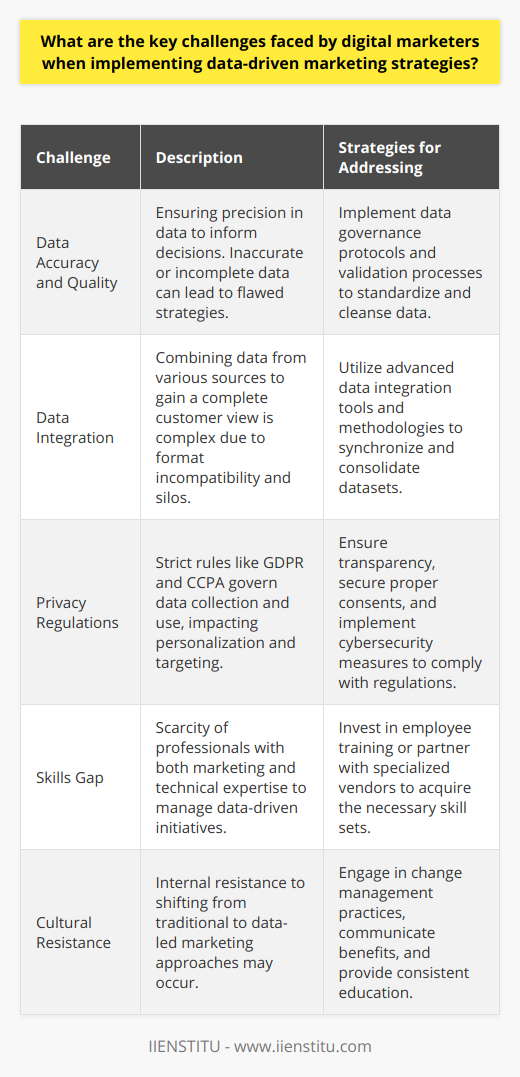
What are the key distinctions between various digital marketing channels, such as search engine optimization, pay-per-click advertising, and social media marketing?
Digital Marketing Channels: Key Distinctions
Search Engine Optimization
Search engine optimization (SEO) encompasses techniques aiming to make a website more visible in organic search results. This implies enhancing the site's structure, content, and backlinks to improve its ranking on search engines such as Google or Bing. Additionally, it includes optimizing for specific keywords and phrases relevant to the target audience, thereby enhancing the probability of attracting more quality traffic.
Pay-Per-Click Advertising
On the contrary, pay-per-click (PPC) advertising is a model wherein businesses pay search engines or other platforms for each click received on their sponsored ads. This method offers an opportunity for quicker visibility and a more targeted approach, as businesses can directly bid on keywords and phrases they want their ads to appear with. Moreover, PPC advertising allows for a controlled ad spend, as marketers can set budgets, monitor campaign performance, and make adjustments accordingly.
Social Media Marketing
Social media marketing (SMM) entails leveraging social networks such as Facebook, Instagram, or Twitter to promote a brand, product, or service. This channel can generate brand awareness, foster customer engagement, and drive website traffic by sharing relevant content, engaging with consumers, and running targeted advertising campaigns. Furthermore, social media platforms offer valuable insights into customer behavior and preferences, which can be utilized to refine marketing strategies and foster a stronger brand-customer relationship.
Comparing the Channels
Each of these digital marketing channels presents unique advantages that cater to specific business objectives. SEO is an effective long-term strategy for increasing organic visibility, which can lead to a sustainable influx of quality traffic and potentially higher conversion rates. Meanwhile, PPC advertising allows for quick results and is ideal for promoting timely offers or gaining exposure in a highly competitive market. Finally, SMM is a powerful tool in building brand identity, promoting customer interaction, and creating a loyal following. By understanding these distinctions, businesses can make informed decisions in selecting the apt marketing channel or adopting an integrated approach to achieve their goals.
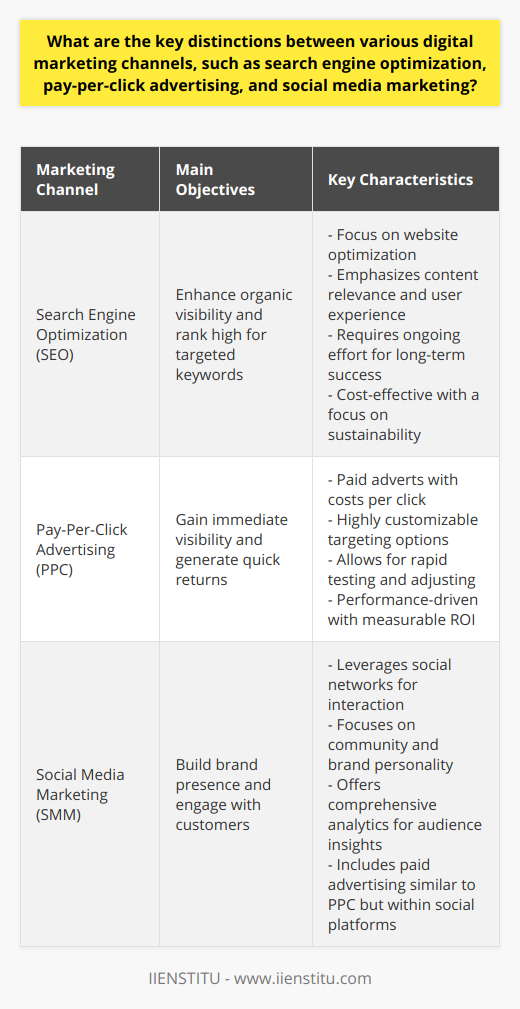
How do online privacy regulations, such as GDPR and CCPA, affect digital marketing strategies and best practices?
Impact on Data Collection and Analysis
Online privacy regulations, such as the General Data Protection Regulation (GDPR) and the California Consumer Privacy Act (CCPA), have significantly impacted digital marketing strategies and best practices. These regulations enforce stricter rules around the collection and use of personal data to protect user privacy. As a result, digital marketers must rethink their data-driven approaches to target audiences effectively and ethically.
Consent Management and Transparency
To comply with GDPR and CCPA, digital marketers must prioritize consent management and transparency. Consent must now be actively given by users, making it critical for marketers to design user-friendly interfaces that provide clear information about data usage. This shift in focus to user consent necessitates more creative methods to entice users to share personal information.
Contextual Advertising as an Alternative
Given these constraints, contextual advertising has emerged as an alternative to targeted advertising using personal data. Contextual advertising focuses on content relevance rather than user behavior, making it a viable option for digital marketers in the age of online privacy regulations. This methodology relies on analyzing the content of a given page to serve ads that are related and relevant.
Quality Content and Trust Building
The enforcement of online privacy regulations has led digital marketers to place a higher emphasis on delivering quality content and building trust with consumers. By developing value-driven content rather than relying on intrusive and data-heavy techniques, marketers can foster positive relationships with their target audience. This approach also improves brand perception and reinforces customer loyalty.
Balancing Compliance and Personalization
Despite the limitations imposed by GDPR and CCPA, digital marketers must still strive for personalization to remain relevant and effective. Balancing this need for personalization with compliance can be achieved through a combination of first-party data collection, privacy-aware technologies, and adaptive marketing strategies. These approaches prioritize the user experience while respecting personal privacy, ensuring a sustainable digital marketing landscape.
In conclusion, online privacy regulations have forced digital marketers to adapt their strategies and best practices to maintain compliance while still delivering effective campaigns. By embracing consent management, focusing on contextual advertising, creating quality content, and finding the balance between personalization and privacy, marketers can achieve success in this new era of digital marketing.
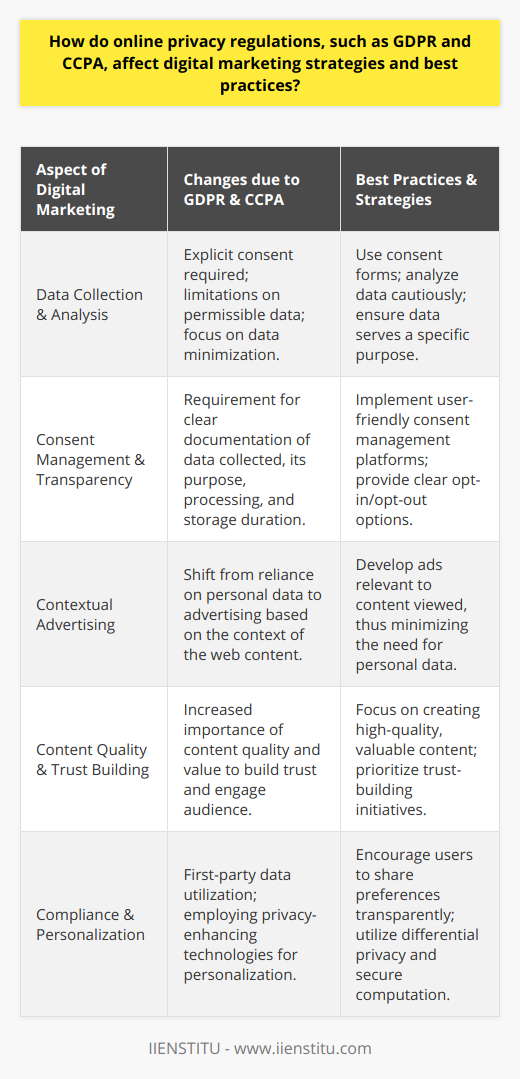
What are the most effective methods for measuring and analyzing the return on investment for a digital marketing campaign?
Key Performance Indicators
To effectively measure and analyze the return on investment (ROI) for a digital marketing campaign, the first crucial step is to establish relevant key performance indicators (KPIs). These are quantifiable metrics that align with the campaign's objectives, such as lead generation, sales, or brand awareness.
Google Analytics and Social Media Metrics
Google Analytics is an essential tool for tracking and analyzing web traffic data, offering insights into user behavior, conversions, and sources of traffic. By combining this information with social media metrics, such as engagement rates, clicks, and shares, marketers can evaluate the effectiveness of their campaign initiatives and adjust their strategies accordingly.
Cost Per Acquisition
A popular method for ROI assessment is the cost per acquisition (CPA) metric, which measures the cost-effectiveness of acquiring new customers through digital marketing campaigns. This metric takes into account the overall budget, conversions, and customer acquisition costs, enabling marketers to compare the efficiency of different marketing channels in driving customer conversions.
Conversion Rate Optimization
Since a higher conversion rate often leads to a higher ROI, conversion rate optimization (CRO) plays a significant role in maximizing campaign returns. CRO involves analyzing user behavior on landing pages and conducting A/B tests to determine which design elements or layouts encourage conversions. With this knowledge, marketers can revise their strategies and boost their campaign's overall ROI.
Marketing Attribution Models
Implementing marketing attribution models helps to understand the impact of each marketing touchpoint in driving conversions. These models, including single touch, multi-touch, and algorithmic attribution, can assist marketers in identifying the most effective channels for their digital campaigns, enabling them to allocate resources efficiently and optimize their ROI.
In conclusion, effectively measuring and analyzing the ROI for a digital marketing campaign requires a multifaceted approach, involving KPI establishment, the implementation of analytics tools, cost per acquisition calculations, conversion rate optimization, and marketing attribution modeling. By employing these methods, marketers can identify every aspect of their digital marketing initiatives and make well-informed decisions for maximizing their ROI.
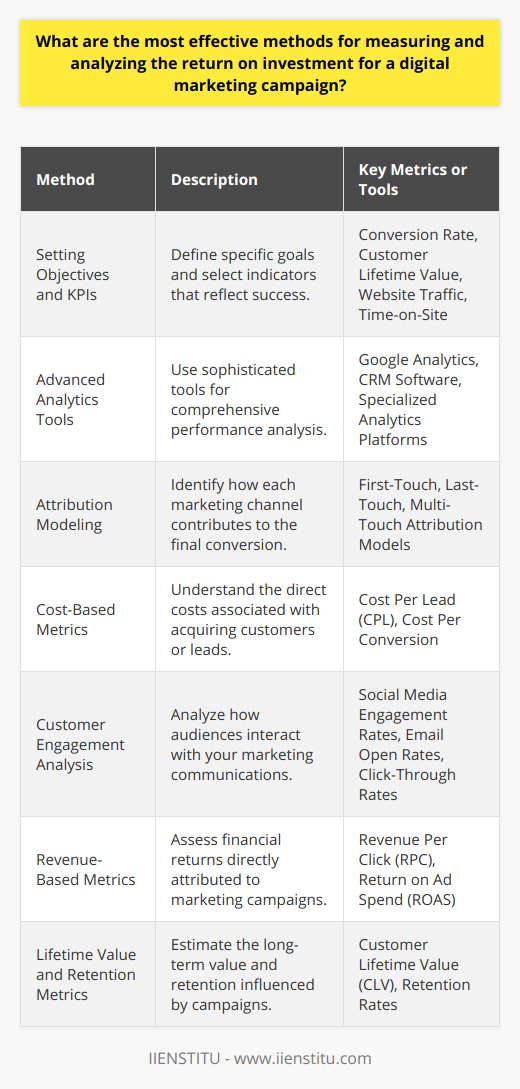
What are the key methods for building and maintaining online reputation in the age of digital marketing?
Effective Digital Marketing Strategies
To build and maintain an online reputation in the age of digital marketing, businesses must consistently engage in effective methodologies that cater to their target audience. One crucial approach is presenting quality content. Sharing well-researched articles, videos, and podcasts increases client engagement and provides a platform for users to interact with the brand.
Utilizing Social Media
Businesses should leverage the power of social media to foster meaningful connections with their audience. Engaging with customers through multiple platforms, such as Facebook, Twitter, and Instagram, ensures a broad online presence. Furthermore, regular updates on new products, company achievements, and customer testimonials enhance the brand's image.
Maintaining a User-Friendly Website
A well-designed, user-friendly website with relevant information and easy navigation is crucial for attracting and maintaining a healthy client base. A well-optimized site helps improve search engine rankings, making it easier for potential customers to discover the company's offerings.
Monitoring Online Reviews
Online reviews significantly influence customers' perception of a business. It is essential to monitor customer feedback across various review platforms, respond to reviews, and address concerns. This proactive approach showcases the company's commitment to customer satisfaction and helps maintain a positive reputation.
Implementing SEO Strategies
Creating and implementing search engine optimization (SEO) techniques, such as keyword research and link building, significantly boosts the site's visibility in organic search results. Higher search rankings attract more potential customers, enhancing the online reputation of a business.
Collaborating with Influencers
In the age of digital marketing, collaborating with influencers and industry leaders is an effective way to reach a wider audience. Partnering with such individuals strengthens brand credibility and adds value to the company's reputation.
Tracking and Analyzing Online Reputation
Monitoring online reputation regularly allows for timely intervention and necessary adjustments to marketing strategies. Employing social listening tools and performing a content audit ensures that the brand's messaging remains consistent and appealing to its intended audience.
In conclusion, securing and maintaining a favorable online reputation entails creating quality content, leveraging social media, optimizing the company website, monitoring and responding to reviews, implementing SEO strategies, collaborating with influencers, and consistently analyzing online reputation. By adopting these key methodologies, businesses can thrive in the digital marketing era and develop a strong online presence.

How can businesses ensure that their digital marketing efforts align with their target audience's needs and preferences?
Understanding Target Audience Preferences
To ensure digital marketing efforts align with the target audience's needs and preferences, businesses must first conduct comprehensive audience research. Analyzing demographic, geographic, and psychographic data enables the identification of key characteristics and preferences of their target consumers, ultimately informing marketing strategies and content development.
Leveraging Data Analytics
Moreover, businesses can employ data analytics techniques to assess the performance of their digital marketing initiatives. Monitoring metrics such as engagement, click-through rate, and conversion rates enables marketers to identify successful content and strategies, ensuring their digital campaigns remain aligned with audience preferences.
Employing User-Centered Design
Adopting a user-centered design (UCD) approach to digital marketing similarly fosters alignment with the target audience's needs. By focusing on user needs and preferences from the outset, businesses can create content and user experiences that cater to their audience, resulting in increased relevance, engagement, and effectiveness of their marketing efforts.
Segmenting the Audience
Audience segmentation allows businesses to tailor their digital marketing strategies to cater to distinct subsets of their target audience, ensuring that the needs and preferences of various segments are met. By doing so, businesses can deliver personalized content and offers to the right audience, bolstering the overall efficiency of marketing campaigns.
Implementing Feedback Mechanisms
Finally, businesses must create opportunities for audience feedback, thereby incorporating the voice of the consumer into their marketing strategies. Soliciting user-generated content, hosting surveys, and engaging in social listening are viable methodologies for acquiring consumer opinions that can inform future marketing decisions and enable better alignment with the target audience's preferences.
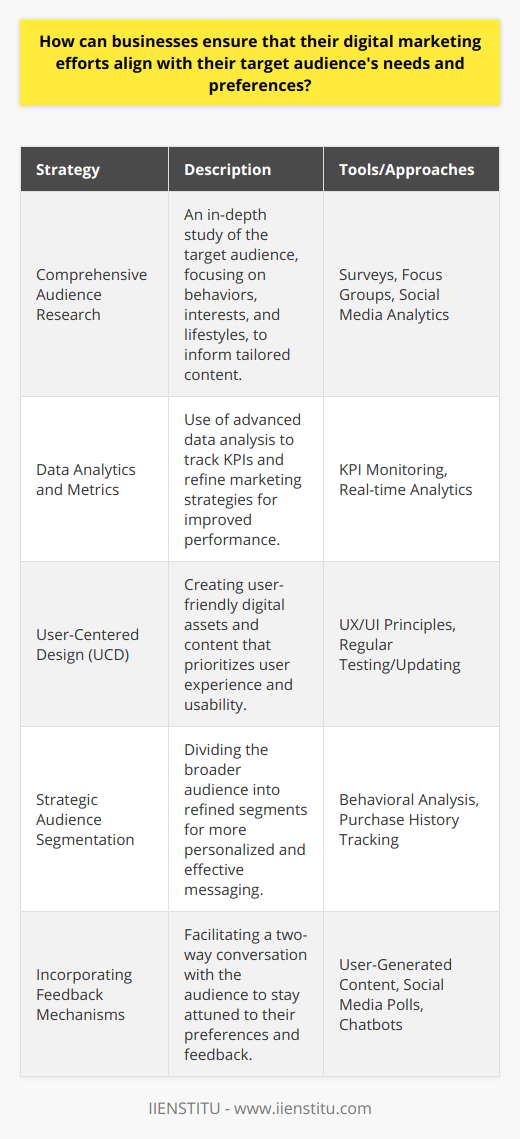
In what ways does the implementation of artificial intelligence and machine learning technologies impact digital marketing strategies and techniques?
Influence on Targeting and Personalization
Artificial intelligence (AI) and machine learning (ML) technologies have significantly impacted digital marketing strategies and techniques in multiple ways. One major aspect is enabling more precise customer targeting and personalized marketing efforts. By analyzing large volumes of data, AI and ML systems identify patterns in consumer behavior, preferences, and demographics. These insights enable marketers to create targeted advertisements and campaigns, resulting in higher conversion rates and customer retention.
Enhancement of User Experience
Another important impact of AI and ML technologies on digital marketing is the improvement of user experience. Through techniques such as natural language processing and sentiment analysis, AI-powered chatbots and virtual assistants facilitate better customer interactions, providing instant support and personalized recommendations. Additionally, AI-driven website and app design help enhance user experience by anticipating user requirements, offering intuitive navigation, and ensuring content relevancy.
Acceleration of Data-Driven Decisions
AI and ML technologies also play a crucial role in informing data-driven decision making in digital marketing. By processing large amounts of data in real-time, these systems generate valuable insights and predictions, such as customer lifetime value, churn rate, and sales forecasting. Consequently, digital marketers can make well-informed decisions regarding campaign optimization, budget allocation, and overall marketing strategies.
Optimization of Content Creation
In terms of content creation, AI and ML technologies have streamlined the process and enhanced output quality. They facilitate the development of engaging and relevant content through techniques such as automated content generation, keyword and topic analysis, and audience segmentation. Moreover, AI-driven analysis of content performance allows for continuous optimization and increased overall effectiveness of marketing campaigns.
In conclusion, the implementation of artificial intelligence and machine learning technologies profoundly impacts digital marketing strategies and techniques. Through enhanced targeting and personalization, improved user experience, data-driven decision making, and optimized content creation, these technologies enable marketers to remain competitive and adapt to an ever-evolving landscape.

